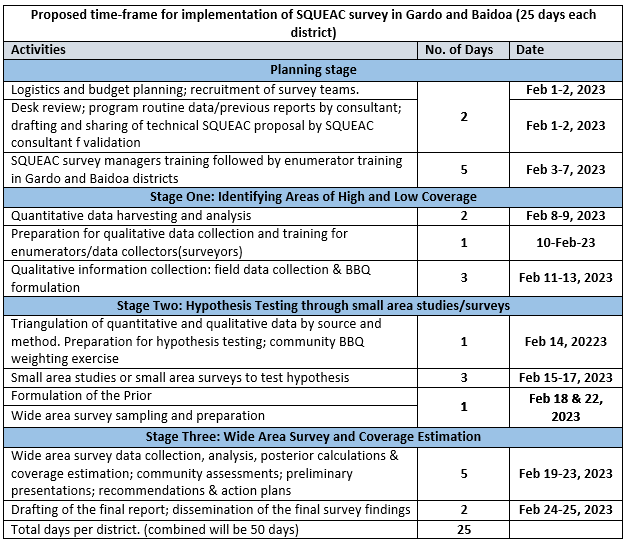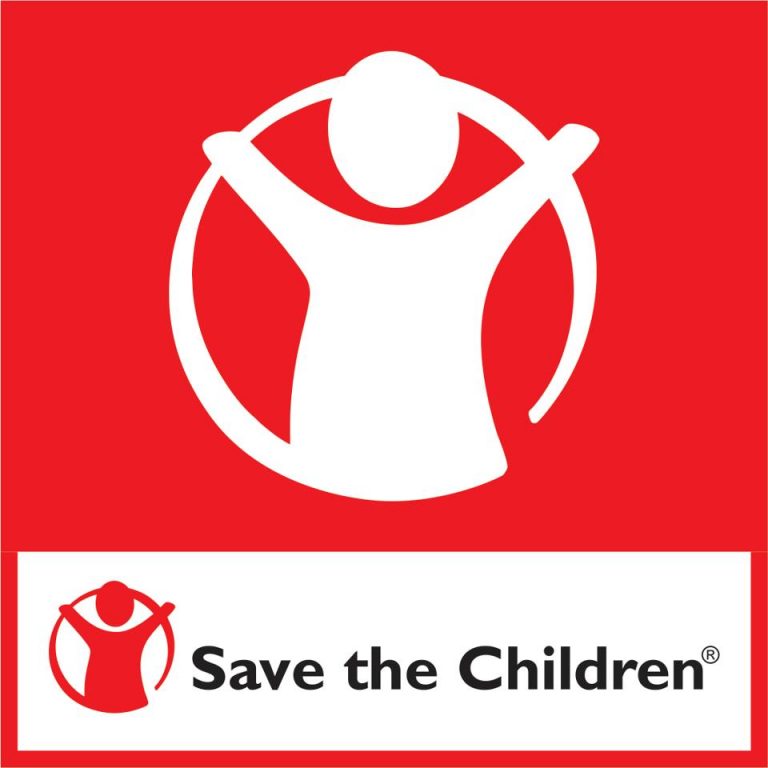Job description
INVITATION TO BID FOR CONSULTANCY
Save the Children International (SCI) Somalia program hereby invites interested consultants to bid for the consultancy assignment detailed below
Title of Consultancy
Terms of Reference (TOR)–Semi-Quantitative Evaluation of Access and Coverage (SQUEAC) Assessment in Baidoa and Gardo District, Somalia.
SCI Contracting Office
Save the Children
Period of Consultancy
50 days starting from contracting date.
Assigment Location
Baidoa, and Gardo districts.
Consultant type required
Individual or Firm
Responsibility for Logistics arrangements and Costs
The consultant will be responsible for organizing logistical issues with no facilitation from SCI as per the consultancy agreement.
Taxation Provisions
Consultant shall be responsible for all Taxes arising from the consultancy in line with the Somalia Tax regulations applicable.
Travel requirements
Consultant will manage any travel costs
Security requirements
Consultant will comply with standard Save the Children Security procedures, including the completion of SCI online security training prior to travel to Somalia
Terms of Reference (TOR)–Semi-Quantitative Evaluation of Access and Coverage (SQUEAC) Assessment in Baidoa and Gardo District, Somalia.
Save the Children is implementing Sustainable Opportunities for More Accessible Livelihoods and Integrated Assistance (SOMALIA) program is implemented in the Bari, Nugal, Awdal, Bay, Bakool and Lower Shabelle regions of Somalia. The overall purpose of the project is to contribute to the reduction of maternal and child morbidity and mortality and build resilience by improving access to safe, quality lifesaving primary health, nutrition, WASH, and protection services for crisis-affected communities, and to help them meet their household dietary needs while seeking sustainable solutions.
The Community Management of Acute Malnutrition (CMAM) is a methodology for treating acute malnutrition in young children using a case-finding and triage approach. Using the CMAM method, malnourished children receive treatment suited to their nutritional and medical needs. Most malnourished children can be rehabilitated at home with only a small number needing to travel for in-patient care. The CMAM model was developed by Valid International and has been endorsed by World Health Organization (WHO) and United Nation’s Children Fund (UNICEF). CMAM was originally designed for the emergency context, as an alternative to the traditional model of rehabilitating all severely malnourished children through in-patient care at Therapeutic Feeding Centres. However, it is increasingly being implemented in the context of long-term development programming, with several Ministries of Health including components of CMAM in their routine services. Through the CMAM program, children who are severely malnourished are managed through the outpatient therapeutic care z(OTP), while children with complication are treated through the in-patient program (Stabilization Centres-SC). Coverage surveys (SQUEAC) are therefore an approach to identify the uptake of the program among the communities being served by the existing CMAM activities. This will inform the CMAM programming.
Baidoa district hosts the second largest IDPS in Somalia and currently experiencing frequent and massive movements of returnees from ravaging drought in the horn. This puts additional pressure on already insufficient and over-stretched nutrition services in the district. As per post-Gu’u FSNAU report, Baidoa IDP has the highest GAM and SAM rates With 28.6% and 10.2%, respectively. Sahal Maaclin Isse Stabilization has received the most admissions since its inception, with 2,855 cases admitted between January and November 2022.
Qardho districts hosts quite number of health and nutrition facilities supported by save the children and other partners through integrated or stand-alone services. The impact of the severe drought in surrounding areas has fueled extensive movement of people to these areas which is a relatively accessible area served by the humanitarian community. Consequently, the already limited and stretched facilities and interventions have been stretched too far by efforts to meet the basic needs of rapidly escalating numbers of newcomers in the three districts. As a result, most arrivals in the three districts are mostly observed to be in a critical nutrition and health situation. Hence a need of a SQUEAC under the BHA project currently ongoing.
Purpose
The purpose of the SQUEAC assessment is to assess the coverage of the CMAM programme and investigate coverage and programme quality indicators. The assessment is expected to identify key factors affecting the uptake of Community Management of Acute Malnutrition (CMAM) services in target areas of coverage on the basis of which specific recommendations are made.
Objectives of the coverage survey
The main objective of this assignment is to evaluate access and coverage of Integrated Management of Acute Malnutrition (IMAM) program using SQUEAC methodology in Baidoa, and Gardo districts.
- To develop the skills of key nutrition staff in conducting access and coverage survey using Semi Qualitative Evaluation of Access and Coverage (SQUEAC) methodology.
- To provide TOT & Enumerator training for Qardho, while Enumerators training will be provided in Baidoa.
- For Baidoa district, conduct a review of recommendations from previous coverage assessment conducted to examine the extent of implementation.
- Analyzing & utilizing available routine program data and other anecdotal data, identify probable low and high coverage areas and reasons for coverage failure.
- Confirm the location of high and low coverage areas and the factors affecting coverage failure identified.
- Map out program single Coverage estimate for the targeted areas.
- To conduct community assessment to understand dynamics and its impact on the access to care and the coverage of OTP/SC services in the targeted district.
- In collaboration with SCI Somalia team, develop specific recommendations to improve acceptance and coverage of nutrition program.
Activities
- To achieve the above-mentioned objectives, the survey consultant will undertake the following:
- Design the survey protocol, develop comprehensive tools for data collection and present it to the Nutrition Cluster AIM working group for validation.
- Conduct training for SCI Somalia nutrition staff on SQUEAC methodology and thereafter guide and supervise them as they take part in the entire assessment.
- Organize adequate supervision and coordination of the survey teams in the field; the consultant should able to conduct field data collection.
- Analyse data and compile a comprehensive coverage survey report
- Present investigation results to SCI technical team as well as the Assessment and Information Management Working Group (AIMWG) for validation
SURVEY METHODOLOGY.
The survey will use the SQUEAC (Semi-Quantitative Evaluation of Access and Coverage) methodology[1]to measure coverage for TSFP and OTP. SQUEAC is a low resource method that can be used on a regular basis to monitor program performance, identify barriers to service access and uptake and hence evaluate coverage. It is an investigation rather than a survey and uses a mix of quantitative (routine program data and small and wide area surveys) and qualitative data (anecdotal information from various relevant respondents). It equally, employs specific statistical analysis to provide an overall coverage estimate and show areas of poor coverage; and the methodology is action-oriented and practical, highlighting appropriate interventions needed to increase Coverage and access. The survey will adopt stages as follows:
Stage 1: Building the prior
The Prior is the expression of beliefs about coverage based on qualitative data. The prior is developed through aanalysis of routine data and other relevant available data to identify areas which suggest low or high coverage. Some of the information needed for this analysis includes program admissions over time, exits (cured, defaulters, non-response and deaths), listing and mapping of all settlements in the catchment area for the nutrition program, home locations of all beneficiaries and defaulters, home location and number of community volunteers. The Selected Districts Health Information System and routine program data shall be used to generate trends.
Stage 2: Building the Likelihood.
In order to improve and make the Prior value stronger more data are added. Collect information from the target communities, beneficiaries and health staff to explain and better inform the program data and build on the hypothesis of high or low coverage. This involves informal group discussions, household interviews where necessary, semi structured interviews and simple structured interviews with respondents such as caretakers, health workers and community health workers in the survey area. The information collected shall be used to triangulate the quantitative information collected in stage1. This stage also helps to identify factors promoting or hindering program coverage.
Likelihood surveys shall be used to test hypothesis of spatial distribution of coverage. The large area surveys shall adopt active and adaptive methodology which involves looking for cases of both moderately and severely malnourished (those in program and those not in programs). Sample size shall be calculated using Bayesian calculator.
Stage 3: Building the Posterior
A SQUEAC Bayesian Calculator here is used to estimate overall coverage of CMAM programme. The software enables the creation of graphs for the Prior, the Likelihood and the Posterior. The Posterior, representing the coverage estimate, is automatically generated by the Calculator indicating a point estimate and 95% credibility interval from the resulting Posterior.
Figure 1: Snap-Shot of the SQUEAC Methodology Stages
2.0 Logistics
As part of the technical proposal, the consultant should clearly indicate the approaches and budget for this engagement. After receiving the inception report from the successful consultant/firm, SCI shall arrange all necessary logistical needs of the survey including travels, accommodation, allowances for field Assistants and partners, transport to the field and other necessary items.
2.1Timeframe and Description of main Activities
This survey will last for approximately 50 days. This period will cover all survey processes including Pre-field preparation, compilation and analysis of routine program data, training of field assistants, field data collection, data analysis and reporting. Notably, field data collection shall cover but not limited to the following: seasonal calendars, labour calendar, food availability, disease patterns, and interviews with caregivers, health workers and small area surveys/studies and large area surveys.

2.2 Team composition and Authority
The successful Consultant shall be under the Supervision of SCI’s research team and nutrition technical specialists. As part of capacity building and nurturing synergies, the surveys will have nutrition program partners participating including Ministry of Health (MOH), other nutrition Implementing Partners and other stakeholders as appropriate and applicable according to the geographical context.
3.2 Technical Proposal Content
Proposals for this consultancy should include the following information (at a minimum)
- Proposed approaches – this should clearly elaborate the methodology and logistics required
- Proposed timelines for each sub-activity
- Proposed budget.
- Curriculum Vitae person intending to lead this investigation.
- Individual/Company Profile – Showing clear experience in facilitating SQUEAC and Coverage surveys. Preferably, include justification that you completed previous assignments with other agencies.
3.3 Expected Outputs from the Survey
During this engagement, the consultant shall be expected to deliver the following to the survey partners
- Prepare survey protocol and a pre-survey presentation; present the same to Cluster AIM WG for validation.
- A well-written survey report with clearly disaggregated findings by district, category (SAM&MAM).
- Soft copy of raw data set for any quantitative data collected should be shared to the relevant team
- Soft copies of qualitative data collected (i.e. interview notes) should be shared to the relevant team.
- Summary MS- PowerPoint presentation of the survey results and the same presented to the relevant team (Following the agreed Cluster Templates)
- A full final report validated by relevant teams (Cluster AIM WG and technical specialists SCI) to be presented before final payment is processed.
- Organisation, Roles and Responsibility
The consultancy will be contracted by and report to Save the Children in Somalia. The project team, country office technical team will also support the survey, providing necessary and available documents and information needed, they will also provide technical assistance.
Location: The consultancy will take place in Gardo and Baidoa districts in Karkaar and Bay regions respectively.
- Terms and Conditions
Professional Fee: The consultant will come up with his/her own rate, which will be subject to negotiation within the bounds of donor requirements, market price and set standards of SC in Somalia. The consultant is expected to estimate daily consultancy fee and international travel costs, while Save the Children will provide will cover other associated costs such as transportations while in the field, accommodations, food expenses, costs for data collectors, vehicle rent, venue, stationary, travel costs, and others.
- Code of Conduct
Save the Children's work is based on deeply held values and principles of child safeguarding, and it is essential that our commitment to children's rights and humanitarian principles is supported and demonstrated by all members of staff and other people working for and with Save the Children. Save the Children's Code of Conduct sets out the standards which all staff members must adhere to and the consultant together with his/her data collection team are bound to sign and abide to the Save the Children’s Code of Conduct.
Skills and qualifications
Qualification and Experience
The consultant should possess the following qualifications
- Extensive experience in nutrition research, SQUEAC surveys, monitoring and evaluation fieldwork (data collection, validation, entry and analysis)
· Experience in leading teams in field (training, field logistic management, human relations, teamwork)
· Prior experience with nutrition, health and food security programming.
· Good knowledge of Somalia and humanitarian operations in fragile contexts. Preferably Somalia national.
· Demonstrable ability and experience in working with communities in a survey setup.
· Demonstrable ability to facilitate capacity building sessions for people with different backgrounds.
· In addition, the consultant should be willing and able to work under a tight timeframe.
Attachments
How to apply
Evaluation Criteria
Candidates interested in the position are expected to provide the following documentation:
· A technical proposal with a detailed response to the TOR, with specific focus on the scope of work, methodology and timelines.
· Initial work plan and indication of availability
· A financial proposal detailing the daily rate expected.
· Company profile or CV including a minimum of 3 references.
· At least two previously conducted similar studies.
Application Procedure
Interested consultants should submit their applications via email to [[email protected] ].
Electronic Submission via ProSave
Ø Submit your response in accordance with the guidance provided in the below document:
The applications should be submitted in PDF format as one document comprising Technical and Financial sections as detailed below.
a) Technical proposal – including but not limited to :
· Consultants understanding of the assignment and context
· Approach to the assignment
· Methodology
· Tools
· Deliverables
· Workplan
· Key staff biodata (Resume)
b) Financial proposal – providing a breakdown of all charges related to the assignment.
c) CV(s) of consultant(s) with minimum of 2 treceable and recent refrences and Company’s Profile & Lead consultant(s) CV(s) (for firms Only).
Applicants should also indicate the date they are available to start working on the consultancy
All applications MUST be submitted on or before the closing date below to be considered for the assignment.
Only shortlisted Candidates will be contacted.
Closing date for Applications
Interested candidates shall submit their applications through [email protected] no latter than 25th January, 2023 at 5:00 PM (EAT Time)
Terms of Reference (ToR)
Complete ToR with details appended below attached herewith as Annex 1.
- Purpose of the consultancy,
- Introduction of the project,
- Background of the consultancy,
- Objectives of the consultancy,
- Proposed methodology and approach,
- Scope of work,
- Key deliverables / outputs
- Activity timelines
Candidates interested in the position are expected to provide the following documentation:
- A technical proposal with a detailed response to the TOR, with specific focus on the scope of work, methodology and timelines.
- Initial work plan and indication of availability
- A financial proposal detailing the daily rate expected.
- Company profile or CV including a minimum of 3 references.
- At least two previously conducted similar studies.
[1] Mark Myatt, Daniel Jones, Ephrem Emru, Saul Guerrero, Lionella Fieschi. SQUEAC & SLEAC: Low resource methods for evaluating access and coverage in selective feeding programs. http://www.brixtonhealth.com/SQUEAC.Article.pdf


